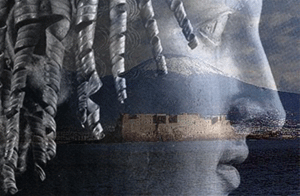
Villa of the Papyri (also called Villa Pisoni) is a suburban villa, which was accidentally discovered in April 1750 during the excavation of a well in Via Cecere. It represents one of the most impressive examples of the roman architecture before the eruption of Vesuvius in 79 A.C. After having brought to light a semircircular veranda which had a magnificent polychrome marble floor, the diggers found a perystile with 64 columns which circled a rectangular swimming pool. On one edge of the swimmig pool the engineer Karl Weber, who supervised the excavations for more than ten years, found a real art collection: bronze and marble objects and sculptures which are now kept at the National Museum in Naples. Karl Weber, who had created a network of tunnels to explore the villa, drew up a plan showing the whereabouts of the various artefacts. The diggers also found, in the oriental side of the villa, a small room which proved to be a library full of carbonized ancient papyri rolls (1800,) probably written in greek by Filodemo da Gadara, an Epicurean philosopher. The difficulty of displaying the papyri rolls is one of the causes of their partial damage. (Part of them was in fact displayed by Paderni and part was later read by father Antonio Paggio). The excavation of the villa was ended soon after the discovery of the library and was restored only in 1985. Researchers are still studying the papyri rolls, hoping to find some written in latin and giving more information about the inhabitants and owners of the villa.
The villa has finally be opened to the public. Visits are possible on Saturdays and Sundays.
Please book through the internet site: www.arethusa.net
If you are coming from a search engine please visit our home page otherwise return to top or to Herculaneum history
|
Home page
|
Up
|